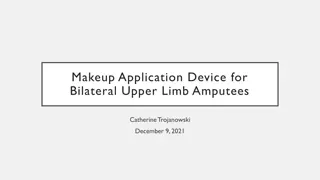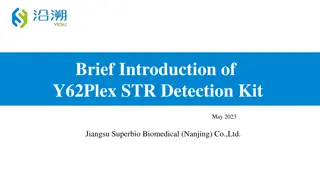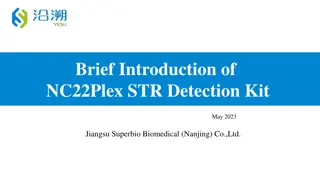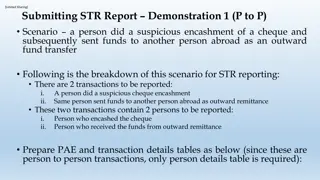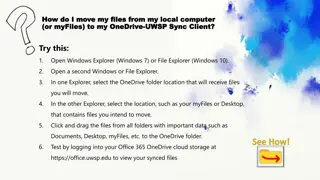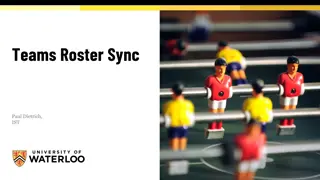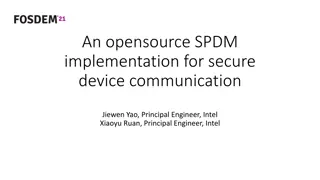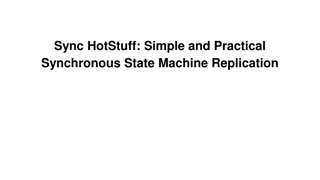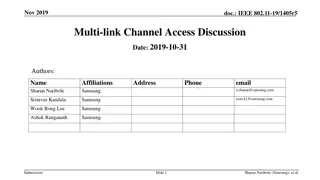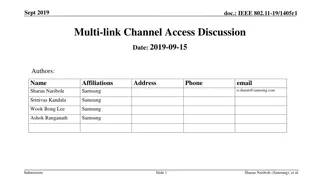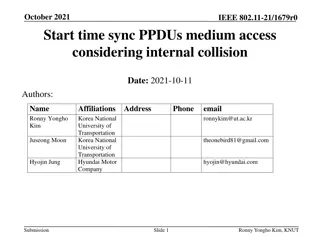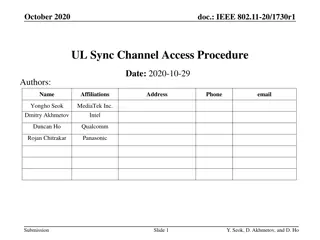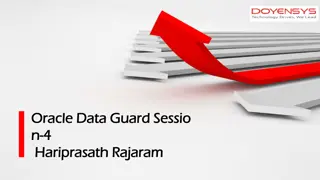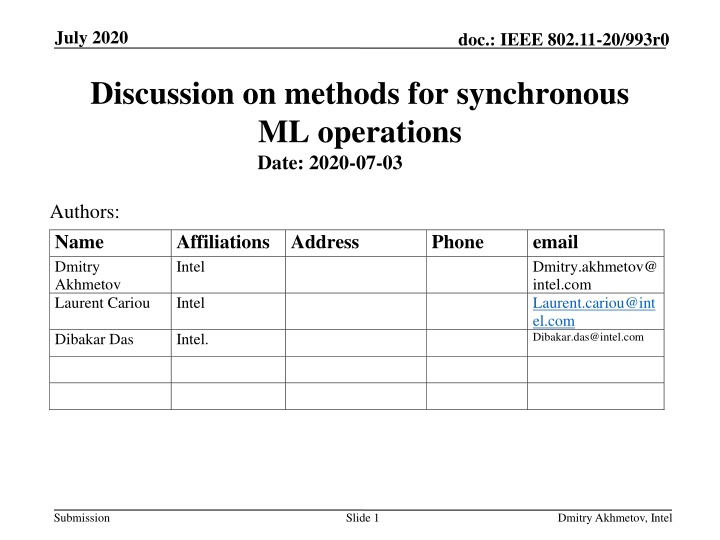
Methods for Synchronous ML Operations in IEEE 802.11-20/993r0
"Explore discussions on proposals for UL aggregation, challenges with concurrent UL/link aggregation, and the need for addressing synchronization issues in non-STR device operations within the IEEE 802.11-20/993r0 document by Dmitry Akhmetov and Laurent Cariou from Intel."
Download Presentation

Please find below an Image/Link to download the presentation.
The content on the website is provided AS IS for your information and personal use only. It may not be sold, licensed, or shared on other websites without obtaining consent from the author. If you encounter any issues during the download, it is possible that the publisher has removed the file from their server.
You are allowed to download the files provided on this website for personal or commercial use, subject to the condition that they are used lawfully. All files are the property of their respective owners.
The content on the website is provided AS IS for your information and personal use only. It may not be sold, licensed, or shared on other websites without obtaining consent from the author.
E N D
Presentation Transcript
July 2020 doc.: IEEE 802.11-20/993r0 Discussion on methods for synchronous ML operations Date: 2020-07-03 Authors: Name Dmitry Akhmetov Laurent Cariou Affiliations Address Intel Phone email Dmitry.akhmetov@ intel.com Laurent.cariou@int el.com Dibakar.das@intel.com Intel Dibakar Das Intel. Submission Slide 1 Dmitry Akhmetov, Intel
July 2020 doc.: IEEE 802.11-20/993r0 Abstract Review of various UL aggregation proposals. Propose to propose a simpler proposal. Simulation showtime Submission Slide 2 Dmitry Akhmetov, Intel
July 2020 doc.: IEEE 802.11-20/993r0 Introduction non-STR device Leakage from TX on link1 cause STA of the same MLD to detect medium as BUSY on link 2 Under such considerations Concurrent UL/Link aggregation in UL is difficult Non-AP MLD still benefit from latency gain DL aggregation may require special treatment for optimal performance Submission Slide 3 Dmitry Akhmetov, Intel
July 2020 doc.: IEEE 802.11-20/993r0 Problem(s) statement(s) There are multiple proposals for link aggregation for both STR and non- STR devices With Primary/Secondary channel. Contention on Primary and PIFS ED check on secondary With independent contention on both links and PIFS access. The winning link does PIFS ED on another link Using independent contention and PIFS access with NAV check Using independent contention and PIFS access with NAV check and slots adjustment AP assisted UL aggregation. STA send TF frame to solicit TF on two links. PIFS may be involved AP initiated UL aggregation. AP use PPDU end alignment to later trigger UL on two links at the same time TBD contention and PIFS access with TBD fix PIFS seems to be in favor as a very efficient and simple option to use despite the following: To not PIFS or not to PIFS that is a regulatory question. Coexistence with legacy devices / STR MLD devices is not studied Submission Slide 4 Dmitry Akhmetov, Intel
July 2020 doc.: IEEE 802.11-20/993r0 Problem(s) statement(s) Independent EDCA operation To get most of ML benefits we treat each link as an independent link for communication Each link have it s own load and it s own interference picture Each link is in sync with other devices operating on that link (i.e. CCA, NAV, etc). PIFS access disrupt this synchronization Each successful transmission on a link reset CW value to MIN. So PIFS-initiated transmission from another link unfairly shorten existing recovery process Each PIFS initiated transmission unfairly shorten channel access time regardless of network state on that link A STA of non-STR STA does not hear a STA ! deafness from another link may require some special handling All these need to be addressed for Combined Channel Access/Link aggregation on non-STR device mode which is designed: Primarily in an attempt to just to fix/enable UL aggregation at non-STR device And very likely only needed for massive/saturated UL case Submission Slide 5 Dmitry Akhmetov, Intel
July 2020 doc.: IEEE 802.11-20/993r0 In an urgent need for UL aggregation Performance/timeline considerations Sync access typically is not frequent Sync access (i.e. medium available for both or more links at the same time) is a function of network load. Chances for sync access is small in a congested network If we to design a mode to enable UL link aggregation at non-STR devices it need to work for both congested and non-congested environments. be network independent need to follow existing regulations be fair to legacy devices as well as STR MLD STAs. not violate/break existing EDCA mechanism Submission Slide 6 Dmitry Akhmetov, Intel
July 2020 doc.: IEEE 802.11-20/993r0 Solution Next, we present potential solutions that are proposed by others in offline and IEEE discussions. We also present our preferred solution in slide 11 and further enhancements to it in slide 17. Submission Slide 7 Dmitry Akhmetov, Intel
July 2020 doc.: IEEE 802.11-20/993r0 Option 0 (PIFS) PIFS based approach: Perform contention on both links. The winning link can trigger transmission on another link if medium of another link is IDLE for PIFS (ED check) Does not solve the unfairness issue since STA still gets more channel access than using regular EDCA. Advance ahead entire backoff sequence Does not take into account interference/congestion on invited links In presence of many non-STR devices can easily lead to double collision STA MLD s backoff UL A-MPDU3 UL A-MPDU1 Link2 DL BA1 UL A-MPDU2 UL A-MPDU4 DL BA2 Link1 Transmit if PIFS IDLE Submission Slide 8 Dmitry Akhmetov, Intel
July 2020 doc.: IEEE 802.11-20/993r0 Option 1 (ePIFS) Enhanced PIFS: Perform contention on both links. The winning link can trigger transmission on another link if medium of another link is IDLE for PIFS (ED check) and NAV not set Invited link shall modify it s backoff counter by some rule, for example, by doubling existing counter or by adding number of slots it took winning link to count down to zero More fair as it add boosted slots back to the counter of invited link This only advance one current contention but not the following ones. NAV check might be a problem Non-STR STA naturally suffer from deafness and may not have up-to-date NAV information Still does not address unequal load problem Lightly loaded link 1 can have multiple opportunities to invite the other link 2 using PIFS access giving unfair advantage over other devices operating on that link 2 Link which is forced to increase backoff counter may be over excessively punished in case of consecutive invites Link alternation may be introduced as solution STA MLD s backoff being 0 DL BA1 UL A-MPDU3 UL A-MPDU1 Link2 Transmit if PIFS idle + No NAV set even if backoff countdown is not zero DL BA2 Link1 UL A-MPDU2 UL A-MPDU4 Submission Slide 9 Dmitry Akhmetov, Intel
July 2020 doc.: IEEE 802.11-20/993r0 Option 2 (Sync Slot) Following successful transmission, both STAs sets backoff count to same value either min or max of two links. Not fair to other STAs if the number = MIN of two links Not fair to itself if number = MAX of two links. More favorable solution Does not rely of blind PIFS ED check Mostly reuses baseline EDCA. More fair to others In congested environment STA may hurt itself in some occasions due to interruption by other STAs Require same sync start time which may not be available SIFS CTS AP Back-off 5 4 3 21 0 6GHz RTS A-MPDU STA Backoff counters of STAs in the MLD are set to the common value. SIFS CTS AP Back-off 5 4 3 21 0 5GHz RTS A-MPDU STA Submission Slide 10 Dmitry Akhmetov, Intel
July 2020 doc.: IEEE 802.11-20/993r0 Proposal (Wait Slot) Each STA of an MLD follows regular EDCA mechanism on each link independently. A STA can perform synchronous PPDU transmission if backoff counters on both links reaches zero the STA on one link may hold the backoff counter at some value until backoff counter on another link reaches same value After that STA continue backoff count down on both links Certainly fair to other legacy STAs and EHT STAs in both link. Does not promote channel access of any STA of the MLD of any link Keep NAV/CCA/contention synchronization with other devices intact Flexible STA may use this if backoff of other link is near completion and/or channel is not expected to change. as STA on one may decide to proceed with transmission w/o waiting the other link does not get penalized in advance for choosing larger backoff window (i.e. do not chose backoff for both links at the same time) As a generalization of option 2, STA on link 1 instead of holding may increase its backoff at any time to align backoffs across links Further optimization possible (see slide 17). CTS Transmission to other STA SIFS AP STA Back-off 321110 6GHz 765 4 RTS A-MPDU Transmission to other STA CTS SIFS AP STA Back-off 3210 5GHz 5 4 9 876 RTS A-MPDU Submission Slide 11 Dmitry Akhmetov, Intel
July 2020 doc.: IEEE 802.11-20/993r0 Simulation results unequal link load 1 AP, 1 STA, 1x1x80, MCS11 Full buffer in UL direction RTS ON, AMPDU = 256 frames Added interference: Link 1 has 1 OBSS Link 2 has 1-8 OBSSes OBSS consist of 1 AP/1 STA with 6Mbps load in both directions 15Kb chunk of data arrive every 20ms (fragmented in 1.5k frames) OBSS STA/AP deliver data using MCS0 Random OBSS TXOP size between 0.5ms and 5ms for every transmission A single 15Kb chunk require ~3.7-4ms for complete delivery Submission Slide 12 Dmitry Akhmetov, Intel
July 2020 doc.: IEEE 802.11-20/993r0 TXOP initiation on a link Non-STR device upon completion of contention on link 1 check status of link 2 Link 1 allowed to initiate TXOP if status of link 2 is IDLE SLOT (i.e. in backoff) PIFS PIFS + NAV not set RX If STA on link 2 is not an intended receiver of ongoing reception Otherwise Link 1 cannot initiate TXOP Submission Slide 13 Dmitry Akhmetov, Intel
July 2020 doc.: IEEE 802.11-20/993r0 Throughput comparison Delta vs ASYNC , async=100% % Load, airtime # BSS Async, Mbps ePIFS, Mbps PIFS, Mbps Wait, Mbps vs ePIFS vs PIFS vs Wait Wait vs ePIFS 0% 20 40 60 80 100 120 140 160 0 1 2 3 4 5 6 7 8 553.9 477.5 354.7 337.0 336.4 333.2 331.4 322.6 331.6 1087.6 600.0 371.3 363.1 361.8 356.1 353.8 355.7 341.6 1094.9 609.4 399.1 389.9 380.9 376.5 372.6 369.0 374.5 1091.2 578.6 369.9 350.3 352.5 349.9 346.1 342.5 340.5 96.3 25.7 4.7 7.7 7.5 6.9 6.8 10.3 3.0 97.7 27.6 12.5 15.7 13.2 13.0 12.4 14.4 12.9 97.0 21.2 4.3 3.9 4.8 5.0 4.4 6.2 2.7 -0.3 3.7 0.4 3.7 2.6 1.8 2.2 3.9 0.3 For low load case performance is nearly identical If network became congested all schemes converge to 1-link like performance of regular Async channel access Async access rulezzz in majority of use cases Submission Slide 14 Dmitry Akhmetov, Intel
July 2020 doc.: IEEE 802.11-20/993r0 Attempts for synchronization Load, airtime = 0% Sync 784 1084 954 923 976 883 Load, airtime = 20% Sync 301 331 297 308 244 247 Load, airtime = 100% Sync 11 79 44 88 18 20 Async 2 3 2 4 2 3 Async 463 464 509 487 587 558 Async 35 1072 191 1006 138 1098 Link 1 Link 2 Link 1 Link 2 Link 1 Link 2 ePIFS PIFS WAIT % of sync transmission With zero/light load a there is a good chance of concurrent synchronous transmissions on two links As network load increase chances dropping to ~10% for PIFS based access and ~3-5% for WAIT access load, airtime 0 20 40 60 80 100 120 140 160 ePIFS PIFS WAIT 99.7 39.2 11.9 10.3 10.1 9.1 9.2 10.3 8.9 99.7 37.8 13.6 12.7 11.8 10.9 9.9 9.7 11.0 99.7 27.3 5.3 3.7 3.8 3.8 3.1 3.6 2.9 Async mean # of unsuccessful invitations for concurrent transmission, recorded at "invited" side Sync mean # of successful invitations for concurrent transmission, recorded at "invited" side Submission Slide 15 Dmitry Akhmetov, Intel
July 2020 doc.: IEEE 802.11-20/993r0 Fairness of medium access on Link 2 Both PIFS and ePIFS access create significant disbalance in access between links In non-congested case WAIT, PIFS and ePIFS provide similar number of SYNC-initiated TXOPs In more congested case with ePIFS-access about 50% or more of transmissions on link 2 are SYNC-initiated. Link 1 (less congested) simply trigger/initiate TXOP on link 2 (more congested) Half of initiated TXOP happens regardless of EDCA state on link 2 Submission Slide 16 Dmitry Akhmetov, Intel
July 2020 doc.: IEEE 802.11-20/993r0 Enhancement to wait slot There may be issue with Wait slot if multiple STAs hold their backoff count to zero and then simultaneously transmit resulting in collisions. Following options to enhance the wait slot mechanism may be considered to resolve this: Option 1(no holding BO at zero): If a link reaches BO equal zero, it may be re-loaded with the current BO count of the other link if the other link is idle. If linkA reaches BO equal zero, and linkB is busy, then link A shall either transmit or draw a new random number without modifying the CW. Option 2 (generalized Option 1): At any time, if both links are idle, the link with the smaller BO count may be re-loaded with the BO count of the link with the larger BO count. If linkA reaches BO equal zero, and linkB is busy, then linkA shall either transmit or draw a new random number without modifying the CW or re-load with linkB BO count. Option 3 (hold BO at zero): When linkB becomes busy, and linkA is waiting at 0: linkA shall not transmit and shall draw a new random number without modifying the CW (internal collision) When linkA becomes busy, and linkA is waiting at 0: linkA shall not transmit and shall draw a new random number without modifying the CW (internal collision) Submission Slide 17 Dmitry Akhmetov, Intel
July 2020 doc.: IEEE 802.11-20/993r0 Summary In non congested environment all solutions work equally well PIFS access looks attractive but comes with inherent defects. Most of PIFS-based variants neither provide fairness nor address issues of unequal link load/congestion Some variations of PIFS-based access can improve fairness to other devices STA but still does not address unequal load/congestion problem All PIFS based methods disrupt regular EDCA operations on a link All are subject to regulatory constraints With minimal changes we introduce a mechanism which utilize existing standard EDCA mechanism Does not require regulatory changes Keep EDCA operation of legacy and STR MLD devices intact Keep fairness to other devices Address (i.e. does not require anything) issue of unequal link load Enable alignment of UL transmissions in a fair way. Submission Slide 18 Dmitry Akhmetov, Intel
July 2020 doc.: IEEE 802.11-20/993r0 Straw Poll Do you support that in 11be a STA that intends to align the start of PPDU transmissions on more than one link may hold its backoff counter of one link to match it to the one on another link to achieve synchronous count down process with the goal of reaching zero on both links at the same time Exact method to decide when to modify slot counter is implementation dependent Submission Slide 19 Dmitry Akhmetov, Intel
July 2020 doc.: IEEE 802.11-20/993r0 Backup Submission Slide 20 Dmitry Akhmetov, Intel
July 2020 doc.: IEEE 802.11-20/993r0 Illustration of unfairness of PIFS Submission Slide 21 Dmitry Akhmetov, Intel
CP July 2020 doc.: IEEE 802.11-20/993r0 CP CP won by STA CP won by other STAs Baseline CP won with PIFS access BO redraw 20 Backoff value at the end of CP: BO:5 BO:0 BO:15 BO:5 BO:0 BO:10 CP CP CP CP CP CP TxOP TxOP ` Doubling remaining backoff Double remaining BO: 10 Backoff value at the end of CP: BO:5 BO:15 ` BO:5 BO:10 BO:20 BO:0 CP CP CP CP CP TxOP TxOP ` PIFS access in previous acquired TxOP also advances this acquired TxOP: unfair PIFS access allows here to access the channel before BO reaches zero Add remaining backoff and redraw BO redraw 20 + remaing BO 5 Backoff value at the end of CP: BO:20 BO:5 ` BO:5 BO:0 BO:10 BO:15 CP CP CP CP CP CP TxOP TxOP ` PIFS access in previous acquired TxOP does not advance this acquired TxOP PIFS access allows here to access the channel before BO reaches zero Submission Slide 22 Dmitry Akhmetov, Intel
July 2020 doc.: IEEE 802.11-20/993r0 CP CP CP won by STA Backoff value at the end of CP: BO:0 BO:15 BO:5 BO:0 BO:15 BO:5 BO:0 BO:15 BO:5 BO:0 BO:15 BO:5 BO:0 BO:10 BO:10 BO:10 BO:10 Link1 CP won by other STAs Lightly loaded channel One TxOP every 4 CP C P C P C P C P C P C P C P C P C P C P C P C P C P C P C P C P C P C P Tx OP Tx OP Tx OP Tx OP Tx OP CP won with PIFS access ` Baseline Independent access per link Backoff value at the end of CP: BO:0 BO:20 BO:16 BO:14 BO:4 BO:0 BO:14 BO:4 BO:0 BO:12 BO:8 BO:6 BO:20 BO:16 BO:12 BO:8 BO:6 BO:18 BO:2 BO:2 BO:10 BO:18 BO:10 Link2 High load channel One TxOP every 11 CP C P C P C P C P C P C P C P C P C P P C P C P C P C P P C P C P C P C P C C P C P C P C P C P C P C P C Tx OP Tx OP Tx OP ` Backoff value at the end of CP: BO:0 BO:15 BO:5 BO:0 BO:15 BO:5 BO:0 BO:15 BO:5 BO:0 BO:15 BO:5 BO:0 BO:10 BO:10 BO:10 BO:10 Link1 Lightly loaded channel One TxOP every 4 CP C P C P C P C P C P C P C P C P C P C P C P C P C P C P C P C P C P C P Tx OP Tx OP Tx OP Tx OP Tx OP ` With PIFS access And add remaining backoff and redraw BO redraw 20 + remaing BO 14 BO redraw 20 + remaing BO 26 BO redraw 20 + remaing BO 38 BO redraw 20 + remaing BO 52 Backoff value at the end of CP: BO:0 BO:20 BO:16 BO:14 BO:44 BO:40 BO:32 BO:28 BO:26 BO:38 BO:54 BO:52 BO:18 BO:42 BO:30 BO:56 Link2 High load channel One TxOP every 11 CP C P C P C P C P C P C P C P C P C P P C P C P C P C P C C P C P C P C P C P Tx OP Tx OP Tx OP Tx OP Tx OP ` Only PIFS access on the highly loaded channel: adding remaining backoff does not solve this unfairness: VERY unfair Backoff value at the end of CP: BO:5 BO:0 BO:0 BO:15 BO:5 BO:0 BO:15 BO:5 BO:0 BO:15 BO:15 BO:5 BO:0 BO:15 BO:5 BO:0 BO:10 BO:10 BO:10 BO:10 BO:10 Link1 Lightly loaded channel One TxOP every 4 CP C P C P C P C P C P C P C P C P C P C P C P C P C P C P C P C P C P C P C P C P C P C P C P Tx OP Tx OP Tx OP Tx OP Tx OP Tx OP Tx OP ` With PIFS access And add remaining backoff and redraw And alternate PIFS access: PIFS access allowed on link1 only if previous PIFS access was on link2 BO redraw 20 + remaing BO 14 Backoff value at the end of CP: BO:10 BO:0 BO:20 BO:16 BO:14 BO:24 BO:20 BO:4 BO:0 BO:32 BO:28 BO:26 BO:18 BO:14 BO:12 BO:8 BO:6 BO:18 BO:22 BO:2 BO:30 BO:16 Link2 High load channel One TxOP every 11 CP C P C P C P C P C P C P C P C P C P P C C P C P C P P C P C P C P C P C C P C P C P P C P C P C P C P C Tx OP Tx OP Tx OP ` PIFS access does not lead to advancing following TxOPs: fair PIFS access allows to advance one TxOP Submission Slide 23 Dmitry Akhmetov, Intel



